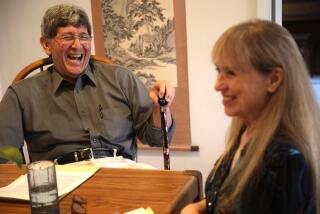Fashionable Cover-Ups for Cancer Treatments
Shelley Hill-Grant was standing in the shower, sudsing in her shampoo, when her hair began to fall out.
“It came out in clumps,” recalled the 34-year-old fashion model and actress during an interview in the airy living room of her Marina del Rey condominium. Within minutes, most of Hill-Grant’s short, curly brown hair--which she’d just had permed and coiffed for $150--was surrounding her feet.
The hair loss wasn’t unexpected, Hill-Grant said as she nibbled on a lunch of fresh strawberries and cheese, but it was still unbelievable. Three weeks earlier, she had begun adjuvant chemotherapy, drug treatment used in addition to primary treatments such as surgery or radiation and designed to kill cancer cells that may have spread from the primary tumor site. The chemotherapy had been strongly recommended by doctors at the Breast Center in Van Nuys, where the cancer in her left breast had been diagnosed. Before the chemotherapy, Hill-Grant had undergone excision of the tumor, removal of lymph nodes and radiation treatment.
Warned of Loss
Before she began chemotherapy, Hill-Grant had been warned by Ellen Waisman, a health educator at the Breast Center--a center for the diagnosis and treatment of breast diseases--that hair loss often accompanied the treatment and for many women was the worst of all possible side effects.
“When Ellen told me the most difficult part of chemotherapy is the hair loss,” Hill-Grant said, “I thought, ‘She’s crazy. She probably thinks I’m a vain little model.’ ”
Even so, Hill-Grant decided to prepare herself for the worst. Her self-designed “desensitization plan” centered on a dramatic hair style change: she decided to get her straight, shoulder-length brown hair clipped and curled. But, as she soon discovered, no amount of preparation could quite ready her for such rapid--and total--baldness.
By the time she stepped from the shower, nearly all of the hair on her head was gone. To make matters worse, she was expected to model at a fashion show that day.
She tried to remain calm. “I called my agent and told her my hair was falling out. Then I started crying hysterically. I didn’t even own a wig or a scarf,” said Hill-Grant, a striking woman with deep brown eyes who works as a runway model for local department stores and as a hand model.
Hill-Grant, who has also appeared in commercials and television shows, missed the fashion show that day. But during the rest of her six-month chemotherapy schedule, she didn’t miss too many other jobs.
Fighting Depression
A few hours after the hysterical call to her agent, Hill-Grant pulled herself together and went shopping for wigs, scarves and hats. During the next two weeks, she said she battled depression and didn’t bother to wear makeup, manicure her nails, or otherwise fuss about her physical appearance.
Eventually, however, she decided the way to feel better was to look better and began drawing on her modeling know-how to survive the effects of chemotherapy. “When I decided to put the effort in, to do head wraps with my scarves, to do my makeup, I looked healthy to myself. I could walk by a mirror and be happy with myself.”
She said she also learned how to “psyche” herself up for chemotherapy sessions by studying guided imagery and visualization and sometimes by “dressing” for the treatments. “Once, I went to chemotherapy dressed in battle gear,” she recalled.
Efforts Rewarded
Hill-Grant’s efforts appear to have paid off. She completed the chemotherapy treatments in late 1984, and is “presently free of cancer,” according to Dr. James Waisman, a medical oncologist at the Breast Center who oversaw her chemotherapy treatments and who noted that “she had worse reactions than average.”
Hill-Grant’s hair, once “stick straight” without a permanent, began to grow back about a year ago and, to her delight, is now naturally curly. At 5-feet-8 and weighing 128 pounds, Hill-Grant looks fit and trim, although she complains that post-treatment weight gain left her eight pounds heavier than her ideal modeling weight.
With her ordeal behind her, Hill-Grant has decided to share what she has learned. Last month, she presented her first free seminar on “Survival Style,” an introduction to a six-week course designed to teach women how to survive the effects of chemotherapy. The course, which spokesmen for local cancer centers say is unique in Southern California, is being offered at the Breast Center in Van Nuys. Cost is $150.
According to the National Cancer Institute, 19,300 to 28,000 women with newly diagnosed breast cancer undergo chemotherapy each year. Adjuvant chemotherapy for breast cancer, which can be administered intravenously, intramuscularly, or orally, is most commonly given every three weeks for six months.
Negative Side Effects
While side effects can include nausea, vomiting, fatigue, a lowered white blood cell count, mood swings and weight gain (or, less frequently, loss), hair loss is often the most critical, according to Waisman.
What to do about that hair loss is a primary focus of Hill-Grant’s course. She explains, among other things, how to use hats and scarves, cautioning against synthetic materials that “tend to slip right off a bald head.”
Also discussed are wig selection, how to replace lost eyelashes and eyebrows, how to adjust makeup when skin becomes dehydrated and sallow as treatment progresses, and how to help dry, peeling fingernails and toenails look healthier. She talks, too, about retaining the skin’s moisture, often depleted by the chemotherapy, and suggests how a sound diet and moderate exercise plan can affect well-being.
Her own devotion to exercise, she believes, improved her outlook. “I went to my regular exercise class once a week and I went to an exercise class for senior citizens twice a week,” she said. “When I’d go to the regular class, I’d be the worst (in the class). When I’d go to the senior citizen class, I’d be the best.”
Hill-Grant also espouses a materialistic philosophy about how to survive the chemotherapy sessions: splurge on whatever helpful items the budget can stand. During her months of treatment, she said she spent $1,000 on a human hair wig and vacationed four days at a posh health spa, adding “When I returned, I had the best chemotherapy session ever.”
For more information about the Survival Style seminars call (818) 787-9911.
More to Read
Sign up for Essential California
The most important California stories and recommendations in your inbox every morning.
You may occasionally receive promotional content from the Los Angeles Times.










